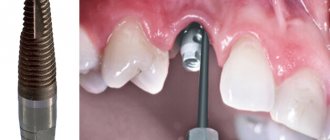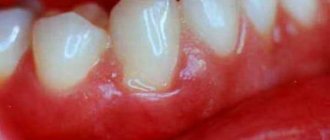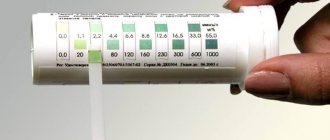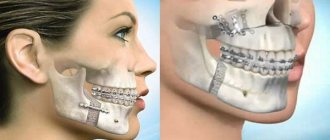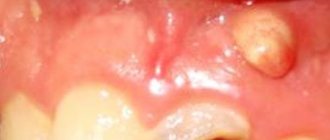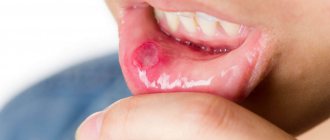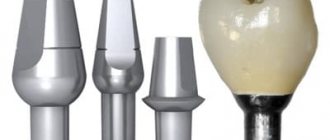Do dental implants fall out? A common question asked by patients who decide to undergo implantation. Every person wants to reduce the risks of surgical intervention, as well as get a guarantee that a new artificial tooth will please you for a long time. Implant manufacturers promise a survival rate of their products in 95-98% of cases. But is it? What determines the rejection of dental implants and how to prevent the loss of dental structures should be clarified before the provision of prosthetic services.
Content
- Description of the problem
- Reasons for implant rejection
- Causes of gum abutment loss
- Features of the patient's body
- What are the consequences of ignoring doctor's recommendations?
- Rejection symptoms
- The implant fell out - what to do?
The use of implants to restore teeth is the most successful procedure in dentistry. But complications can arise with any surgical intervention, even in our time of high dental technology. Is it possible to improve the situation, and what should be done?
What to do if a tooth implant falls out
When calling the dentist with the question “a tooth implant has fallen out - what to do,” patients often mean a crown that has fallen off, a gum former or abutment that has become twisted. Some problems can be solved quickly and easily. Others may require long-term and extensive treatment:
- Screw-retained crowns often unscrew and become detached. The use of a cement composition makes the fastening stronger and allows you to preserve the same prosthesis.
- If a crown falls out due to an incorrectly selected prosthesis, it involves the production of a new artificial tooth and its installation on an existing implant.
- A common situation is that the gum former falls out. The doctor reinstalls the old one or exchanges it for a new one. The task is ordinary and does not affect the process of osseointegration and the implant itself.
What to do if a tooth implant pin falls out? Loss of an implant most often occurs due to inflammation - this is the last stage of peri-implantitis, when it is no longer possible to save the artificial root. The initial stage of tissue inflammation (mucositis) and even the first symptoms of peri-implantitis give a favorable prognosis with a high probability of saving the rejected implant.
Why can a gum abutment fall out?
- The reason may be a loose connection due to the titanium rod being installed too deeply. As a result, bone tissue grows, preventing the molder from being properly fixed.
- The development of an inflammatory process due to insufficient oral hygiene;
- The rod does not adhere tightly to the bone because its density is too low.
Developers of modern implantation systems see the creation of structures that are natural for the oral cavity as a priority. In particular, biocompatible titanium is used.
The thread of the implant allows installation with the most durable fixation and minimal trauma. The body perceives such structures as family.
The duration of engraftment depends on the characteristics of a particular organism.
What is an implant, and what part of the structure can fall out after installation?
A dental implant is a multi-component dental product that is inserted into the patient’s bone tissue and replaces the roots of a lost tooth. A mandatory stage of implantation is osseointegration, the process of creating anatomical and functional connections at the molecular level between the surface of the implant and bone structures. In simple words: the implant fuses with the bone and is securely fixed in the gum. It falls out extremely rarely.
Usually, the question of why a tooth implant fell out hides another problem - with one of the elements of the implanted structure.
Worth sharing:
- implant - a “tooth root” made of titanium or titanium alloy, directly implanted into the bone;
- gum former – a supporting element that guarantees the preservation of gum volume during the process of engraftment of artificial roots;
- abutment – an adapter for attaching a crown or prosthesis to a titanium implant;
- suprastructure is a collective term for abutments and gingival formers.
A common reason for implant failure is ignoring doctor’s recommendations.
Failure to follow recommendations and lack of proper care is the most common cause of complications in the postoperative period and implant loss.
Factors provoking undesirable consequences:
- Smoking, drinking alcoholic beverages and drugs;
- Lack of proper nutrition;
- Not using preventive medications;
- Eating food at different temperatures immediately after installation of the prosthesis;
- Lack of proper oral hygiene;
- Lack of regular visits to the dentist's office;
- Uncontrolled use of medications.
The most dangerous complication is viral infection of the tissues around the installed implant - reimplantitis.
Is it possible to replace a lost dental implant?
If complications have become irreversible and it is not possible to save the prosthesis, the question of reimplantation arises. It includes:
- removal of the implant (if it has not completely fallen out);
- elimination of inflammation, disinfection of the wound channel, removal of pus (if necessary);
- rehabilitation period;
- taking medications;
- sinus lift (if necessary) - bone tissue augmentation;
- installation of a new implant.
The interval between the moment when a dental implant falls out and reimplantation is several months. At this time, the patient must carefully monitor the condition of the oral cavity, regularly perform all hygiene procedures, rinse with a medical solution and strictly follow all the recommendations of the dental surgeon.
According to statistics, the percentage of implant rejection is extremely small - only 1-5%, depending on the manufacturer, and the majority of them are due to the fault of the patients themselves, who violate the rules of the rehabilitation period. In general, implants take root quickly and delight their owners with a beautiful smile for many years.
Symptoms of implant rejection
The first signs of reimplantitis:
- Pain;
- Swelling;
- Bleeding;
- Feeling of discomfort.
If you don’t see a dentist with these signs, the situation will get worse. The following symptoms will be added:
- Implant mobility;
- Growing pain;
- Bad breath;
- Pus appears in the area of the operation;
- Body temperature rises.
- The gum cuff changes due to the inflammatory process.
Signs of implant loss of stability
The following prerequisites indicate that an artificial tooth can cause serious trouble:
- Swelling and discoloration of the gums at the implantation site.
- The appearance of pain when chewing or pressing on the gums near the implant.
- Bleeding or purulent discharge from the socket at the point of implantation of the artificial tooth root.
- Increased body temperature and deterioration in general well-being.
- Perceptible mobility of the implant or crown itself.
What to do to prevent the situation
- The risks are minimal when dental restoration surgery is performed by an experienced doctor in a well-equipped clinic. Large Centers do not skimp on equipment and staff training. When choosing a dentist, you can rely on reviews from patients who have already undergone treatment there.
- Go through a full examination, tell the doctor about all your health problems, without hiding anything.
- When choosing implants, you should not save money; in this situation, the price is proportional to the quality. Popular brands have more guarantees and fewer risks.
- Follow the doctor's recommendations in the postoperative period, including giving up bad habits.
What do we do to avoid unpleasant consequences?
We install Nobel Biocare implants
Produced by the Swiss company of the same name. The survival rate is 99.3% - the highest rate in dental implantology. They solve any edentulous problems, even against the background of acute jaw bone deficiency. They have their own markings to protect against counterfeiting. Equipped with a patented micro-structured porous surface TI-Unite, which accelerates the osseointegration of the rod with the jaw tissue and activates regeneration processes. Nobel implants have a lifetime warranty.
We exclude contraindications
Before implantation, it is important to exclude the patient from diseases that could negatively affect the implant’s healing. Among them: blood diseases, uncompensated diabetes mellitus, pathologies of the immune system, oncology. To identify health problems, the patient is prescribed blood tests, computed tomography, and, if necessary, consultations with other specialists, such as a cardiologist, endocrinologist, phlebologist, or ENT specialist. In our Center, during the period of implantological treatment, correction of chronic diseases is carried out, and a full-time ENT doctor also conducts consultations.
We develop a treatment plan
Planning is an important step in preparing for surgery. Provides for the selection of implant models, their location in the jaw, taking into account the anatomical features of the dentofacial apparatus and the condition of the bone. Our Center performs computer modeling to ensure surgical accuracy, reduce the likelihood of complications and predict treatment results.
We maintain sterility
This is the main condition for successful implantation. During the procedure, the doctor uses only clean instruments and uses antiseptics to disinfect the oral cavity. Each implant is packaged in a sterile box, which is opened immediately before installation. The risk of infection is zero.
We act according to installation protocols
Our doctors were trained in the most modern high-tech training centers. They are fluent in advanced treatment methods and successfully apply them in practice. We use only original components and installation protocols that speed up engraftment.
We take action in a timely manner
The rehabilitation period is constantly monitored by a doctor. We invite patients for examinations, give recommendations on caring for the installed structure, nutrition, and lifestyle. The doctor is on call around the clock if the patient has any questions about treatment.
Sinus lift - why do they lift the maxillary sinus?
In conditions of deficiency of bone tissue of the upper jaw, when implanting chewing teeth, a sinus lift is performed, which avoids perforation of the maxillary sinus and securely fixes the implant. The procedure is carried out using an open or closed method. The first is used for severe atrophy and involves complex surgical intervention. The second is less traumatic and is often performed simultaneously with implantation.
The open protocol includes the following steps:
- Introduction of anesthesia.
- Dissection and peeling of the gingival mucosa in the projection of the sinus.
- Formation of a lateral window in the alveolar process that opens inward.
- Raising the bottom of the maxillary sinus with a special tool.
- Filling the resulting void with bone material.
- Fixation of the barrier membrane.
- Stitching.
In this case, implantation is carried out after complete healing of the tissue (after 3-6 months).
The closed method includes:
- Anesthesia.
- Preparing the jawbone for a hole for a dental implant.
- Upward displacement of the bottom of the nasal sinus with a special instrument.
- Filling the resulting space with bone replacement material.
- Implant installation.
- Stitching.
- With extreme care (strictly according to its height), a hole for the implant is created in the bone.
- Using a special instrument, the bottom of the maxillary sinus is shifted upward.
- The resulting space is filled with bone material.
- The implant is fixed and the mucous membrane is sutured.
Neglecting a sinus lift before implantation of the upper chewing teeth can lead to the following consequences:
- further atrophy of the jaw bone;
- loosening of the titanium structure;
- migration of the implant into the maxillary sinus;
- rejection.
Recovery methods
If alarming changes appear in the area of the installed implant, you should make an appointment with your dentist immediately. Timely anti-inflammatory therapy can prevent structural loss.
The rod may have to be removed, for example, if peri-implantitis develops with loss of bone tissue. In this case, the doctor can install another implant no earlier than two months later. This is preceded by an analysis of the causes of rejection and careful preparation for a new operation.
Reasons for unscrewing an implant with a pin
dental implant with a pin gets twisted and
, which is quite rare, the main reason, as a rule, is a medical error or the use of a low-quality orthopedic structure for implantation.
Common causes of implant unscrewing:
- poorly performed antiseptic treatment;
- incorrectly selected system for installation with load calculation;
- inattentive study of the patient’s personal history.
Unscrewing of the implant 1-2 years after the implantation procedure can only occur due to the fault of the patient who did not follow all the recommendations of the attending physician for the care and use of the artificial tooth.
How does an implant normally take root?
After installation of the implant, a period of osseointegration with the jaw tissue begins, which is divided into three stages:
- Initial (3-4 weeks). Accompanied by the formation of spongy bone tissue around the implanted titanium rod. Until it is strong and has low density, chewing loads can negatively affect engraftment.
- Formation of mature bone (16-18 weeks). The spongy tissue is replaced with lamellar tissue, which completely fills the space between the implant and the areas of bone damaged during installation.
- Final (up to one and a half years). The artificial root finally fuses with the bone tissue. However, after 3-4 months on the lower jaw and 5-6 on the upper jaw, the bone acquires sufficient density. The difference in timing is due to the anatomical and physiological characteristics of bone tissue.
Installation
The most progressive method of restoring an attractive smile today is immediate or “one-day” implantation. In this case, the dentist installs the pin itself and a temporary crown made of plastic or acrylic in just a few hours of work. In this case, tissue deformation is simply excluded, and the aesthetics of the dentition is not disturbed, so there is no point in attaching the former.
Where is the shaper installed? An implant of any size has a small recess; it is designed specifically for screwing in an adapter (abutment) or gum former. If the load occurs on the same day as the installation of the artificial root, then the cylinder is screwed in immediately. This does not require sutures, which makes the procedure less traumatic.
After the implantation of the structure and in the absence of any complications, the cylinder is carefully removed several months later. In its place, a smooth and even hole is formed, where a temporary and then a permanent crown will be fixed.
Possible reasons
Any implant is a foreign body for the body. In order for it to take root well, it is necessary to follow the doctor’s recommendations after the operation. If you ignore the dentist's instructions, inflammation may occur, causing the structure to become unstable.
The main reasons for implant failure also include:
- installation of an unsuitable design - a product with a small diameter or length, made of metal alloys to which there is an allergy;
- mistakes made by the doctor during the operation - overheating of the bone tissue, violation of asepsis, tightening the rod too much;
- malocclusion - crowding of teeth, midline displacement, retrusion and protrusion, transposition, rotation;
- mechanical damage - bruises and fractures, causing displacement of the implant;
- chronic diseases - diabetes, immunodeficiency, blood clotting disorders.
Before installing an implant, the doctor must collect an anamnesis, conduct a comprehensive diagnosis and select a suitable design taking into account the clinical picture.
Diagnosis and treatment
To determine why the implant twists or falls out of the gums, it is necessary to undergo a comprehensive diagnosis. It includes:
- visual examination in the dentist's chair,
- radiography,
- bacteriological analysis of a smear from the oral mucosa.
The specialist will determine the negative factor and tell you whether the implant can be saved or whether a repeat operation is necessary. The structure can be saved if the implant has not become loose and the bone tissue has not lost volume. In other cases, reimplantation is usually indicated.
How is it diagnosed?
- Probing the hole . It involves inserting a special thin probe into the hole for the implant to visualize the presence or absence of the bone bottom. If there is perforation, the probe moves inside without hindrance
- X-ray. It is carried out to fix the accumulation of blood in the sinus (darkened areas in the picture), the presence of fragments of dental roots or implants, and remnants of filling material.
- CT scan. Allows you to obtain the most accurate information about the presence of foreign bodies in the sinus and determine the exact location of perforation.
- Blood test. It is prescribed in advanced cases in order to assess the negative consequences for the body as a whole.
How to prevent
Preventive actions on the part of the doctor include:
- thorough examination of the maxillofacial apparatus at the preparatory stage for implantation;
- correct selection of rod models;
- checking the condition of the nasal sinus membrane during sinus lifting and implantation.
From the patient's side:
- strict adherence to postoperative recommendations;
- extreme caution when blowing your nose and coughing;
- quitting smoking and drinking alcohol;
- elimination of pressure drops.


